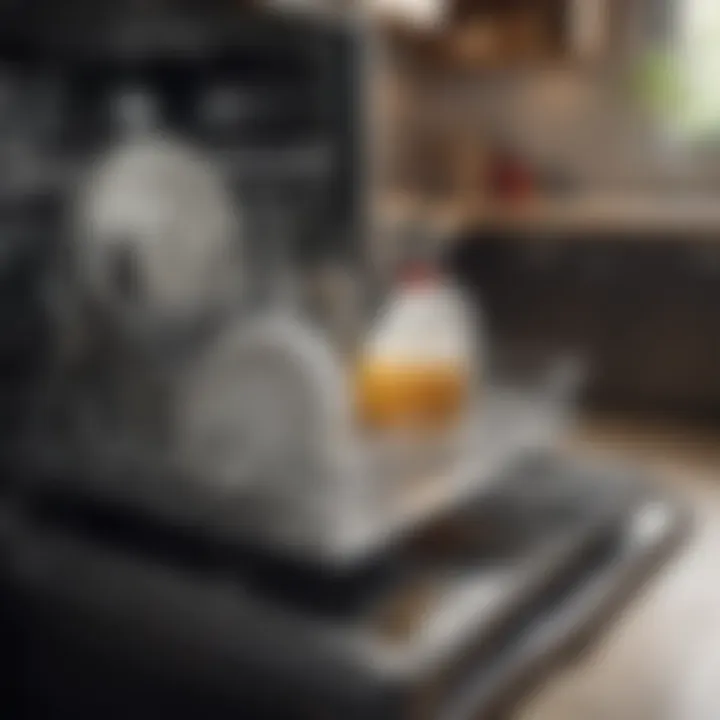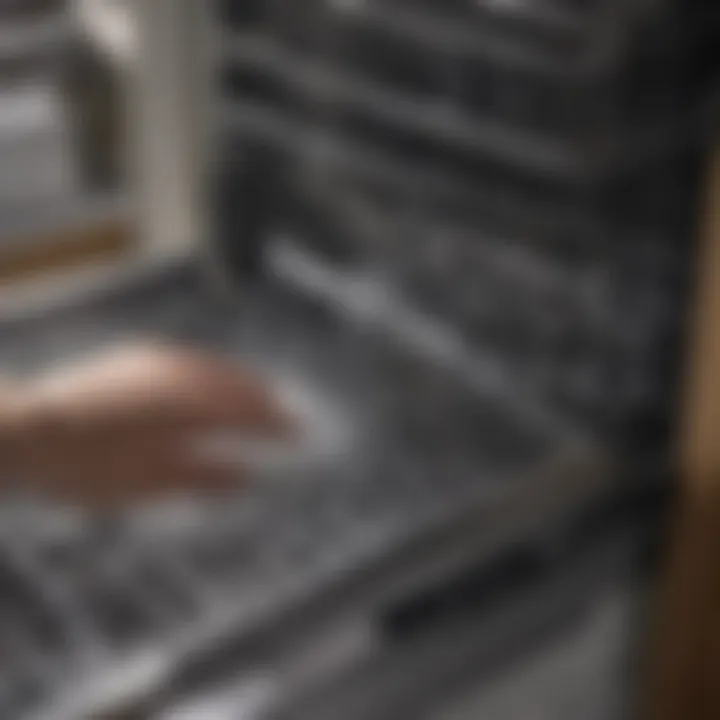Effective Strategies for Cleaning a Clogged Dishwasher


Intro
Every homeowner faces the challenge of maintaining their appliances, and dishwashers are no exception. A clogged dishwasher can disrupt the smooth operation of a household. Understanding how to clean this crucial machine is essential. This article covers effective strategies to tackle clogs, provides insights into maintenance, and helps ensure optimal performance.
Understanding the Clog
Before diving into cleaning methods, it is important to know what causes a dishwasher to clog. Various factors can lead to the accumulation of debris, food particles, and grease. Common culprits include:
- Food debris: Large pieces of food can easily block the drainage system.
- Grease buildup: Over time, grease can cling to the walls of the dishwasher and cause clogs.
- Hard water deposits: Mineral buildup can create obstructions in pipes.
Recognizing these causes allows homeowners to develop strategies for prevention, reducing the frequency of clogs.
Cleaning Techniques
Once a clog is identified, it’s crucial to have a plan for cleaning it out. Here are detailed steps:
- Empty the Dishwasher: Begin by removing all dishes and utensils to access the drainage area.
- Inspect and Clear the Drain: Check the drain at the bottom for any visible debris. Use gloves to pull out any blockages.
- Clean the Filter: Many dishwashers come with removable filters. Take it out and rinse it under warm water to remove any trapped food particles.
- Run a Cleaning Cycle: Use dishwasher cleaning products or household items such as white vinegar. This step can help break down any buildup inside the machine.
- Inspect Hoses: If the dishwasher uses a hose to drain, inspect it for kinks or blockages. Detaching the hose can help in thorough cleaning.
"Regular maintenance is essential to keep your dishwasher operating efficiently."
Preventive Measures
To minimize future clogs, consider integrating these preventive practices into your routine:
- Scrape dishes: Before placing items in the dishwasher, scrape off large food particles.
- Run hot water: Before starting the dishwasher, run the tap for a minute to ensure hot water begins the cycle.
- Check the filter regularly: Cleaning the filter every month can prevent debris accumulation.
- Use salt and rinse aids: These can help manage hard water issues and keep the dishwasher running smoothly.
Maintenance Tips
Regular maintenance extends the life of the dishwasher. Here are some effective maintenance tips:
- Clean the rubber gaskets: Wipe down the door gaskets with a damp cloth regularly to prevent mold and buildup.
- Inspect the spray arms: Occasionally, check the spray arms for debris or clogs.
- Run empty cycles: Running an empty cycle with vinegar monthly can help remove unwanted buildup.
End
Understanding how to clean and maintain a dishwasher is pivotal for any household. By recognizing the causes of clogs and implementing thorough cleaning methods, one can enhance the appliance's lifespan. Preventive measures and consistent maintenance ensure the dishwasher continues to operate efficiently, saving time and effort in everyday kitchen tasks.
Understanding Dishwasher Clogs
Understanding dishwasher clogs is crucial for maintenance and functionality of this essential kitchen appliance. Dishwashers are designed to facilitate the cleaning of dishes efficiently, but when clogs occur, it disrupts the entire cleaning process. Proper drainage ensures that water flows freely and does not pool inside the machine. A clogged dishwasher can lead to unsanitary conditions, unpleasant odors, and ultimately, the need for expensive repairs.
The Importance of Proper Drainage
Proper drainage is the backbone of any dishwasher's effective operation. Adequate drainage prevents standing water from accumulating, which can breed bacteria and mold. When water drains smoothly, it not only keeps the interior clean but also helps maintain the appliance's mechanical components. Moreover, proper drainage prolongs the longevity of the dishwasher, as it reduces strain on the motor and pump systems. A well-maintained drainage system is, therefore, essential for optimal appliance performance.
Common Causes of Clogs
Identifying the common causes of clogs can significantly simplify the cleaning process. Here are the key contributors:
Food Particles
Food particles are one of the primary causes of dishwasher clogs. These remnants can accumulate in filters and drain areas over time. Dishwashers are effective in removing food, but large or stubborn particles can escape the wash cycle, leading to blockages. Keeping larger food scraps out of the machine is essential, as they can impede water flow and damage the appliance.
Soap Residue
Soap residue also plays a significant role in creating clogs. Over time, detergent can build up, forming a thick layer that restricts water drainage. Choosing the correct type of detergent and using it in moderation can mitigate this problem. Soap residue can attract grime and dirt, further exacerbating the clog issue.
Hard Water Deposits
Hard water deposits create a unique challenge for dishwasher owners. These deposits consist of minerals such as calcium and magnesium that accumulate over time. If not addressed, hard water can lead to significant buildup within pipes and coils. Regular cleaning and the use of specific products can help alleviate these stubborn deposits.
Foreign Objects
Foreign objects, such as small utensils or packaging materials, often lead to unexpected clogs. Such items can block filters or the drain hose, resulting in a malfunctioning dishwasher. Regularly inspecting the dishwasher before and after usage is vital to prevent these occurrences.
By understanding these common issues, homeowners can take proactive steps to prevent clogs and maintain a well-functioning dishwasher.


Identifying Signs of Clogs
Identifying signs of clogs in a dishwasher is crucial for maintaining its performance. Recognizing these indicators early can save time, effort, and potential repair costs. When a dishwasher malfunctions, it often manifests through certain symptoms that can be addressed effectively. Homeowners should know what to look for, as timely intervention can prevent further damage and restore functionality quickly.
Water Not Draining
One of the most telling signs of a clogged dishwasher is when water fails to drain properly. This issue often becomes apparent at the end of a wash cycle. Instead of emptying into the drain, you may find standing water at the bottom of the machine. This stagnant water can lead to unpleasant odors and even encourage mold growth.
If you notice water pooling, it's essential to check multiple components, including the drain filter and hose. Water accumulation can indicate a blockage in one of these parts, which requires immediate attention to avoid further complications.
Unpleasant Odors
Unpleasant odors emanating from the dishwasher are another sign of potential clogs. If your appliance gives off a musty or foul smell, it could result from decomposing food particles or stagnant water trapped within. Such odors indicate not just a clog but also an unhealthy condition that can affect your kitchen environment.
To address the issue, inspect the interior for any visible debris and carry out a thorough cleaning. Additionally, employing simple methods like washing with vinegar can help neutralize unwanted smells and promote an overall fresh scent. Ignoring these odors can lead to a less pleasant kitchen experience.
Dirty Dishes After Cycle
Finding dirty dishes after running a cycle is frustrating and often a clear indication that your dishwasher has a clog. While some debris might remain if the dishwasher is overloaded, consistently dirty dishes may point to a malfunction in the appliance’s cleaning ability.
This issue could be caused by a blocked spray arm or clogged filter, which impedes proper water flow and reduces pressure. Regularly checking these components will ensure sufficient cleaning performance, making sure that your dishes come out sparkling clean.
Overall, being aware of these signs helps to keep your dishwasher in optimal working condition. Addressing the problems as they arise will enhance the lifespan and efficiency of your appliance.
Initial Steps for Cleaning
Cleaning a clogged dishwasher requires systematic action. Many might underestimate the role of initial steps. However, these actions set the foundation for efficient cleaning and help avoid further complications. The initial steps ensure that the cleaning process can be conducted safely and effectively without unnecessary damage to the appliance or creating a mess in the kitchen. The following subsections break down essential early actions for homeowners tackling clogs.
Clearing the Area Around the Dishwasher
Before diving into any cleaning procedures, it is crucial to clear the area around the dishwasher. This step minimizes the chances of accidents and provides an unobstructed workspace. It is also practical because you might need space to maneuver tools or to manage any excess water that may spill out during the cleaning process.
- Remove any items on the countertop above the dishwasher.
- Clear the floor space to avoid tripping hazards.
- Ensure access to nearby cabinets, if necessary, for storage of cleaning materials.
Having a clean and organized area contributes to a smoother overall experience. Not only does this make it easier to focus on the task at hand, but it also ensures that you won't have to interrupt the process later on to move things around.
Removing Dishes and Utensils
The next logical step is to remove all dishes and utensils from the dishwasher. This action may seem simple, but it is vital. Leaving items inside can lead to further blockage or damage when attempting to clean the appliance. Ensure to empty the dishwasher entirely before proceeding.
- Sort items by category as you remove them, making it easier to put them back later.
- Inspect each item for remaining food particles or residues that could contribute to future clogs.
Taking the time to thoroughly empty the dishwasher lays important groundwork for the cleaning process. It allows better access to the filter and the spray arms, which are often necessary to clean for optimal function.
Disconnecting the Appliance (if necessary)
In certain situations, it may be necessary to disconnect the dishwasher from power sources or plumbing to conduct a full cleaning. This step depends on the severity of the clog and the method of cleaning you intend to employ.
- Locate the power supply or plug and turn off the power supply to avoid electrical hazards.
- If the dishwasher is hardwired, consider calling a professional.
- For plumbing disconnections, ensure you have towels or a bucket ready to catch any residual water.
Taking this precaution not only secures safety during the cleaning process, but it also allows for deeper access. You can check connections and perform thorough water flow assessments without risking a short circuit or leaking water.
Cleaning the Filter
Cleaning the filter is crucial for maintaining the efficiency of your dishwasher. A clogged filter can hinder proper drainage and lead to unpleasant odors. Regularly cleaning the filter ensures that your dishwasher operates effectively and helps in preventing food particles and grime from circulating during the wash cycle. This step is simple yet essential for the longevity of the appliance. It also contributes to better washing results, ultimately improving the overall hygiene of your dishes.
Locating the Filter
The filter in a dishwasher is typically located at the bottom near the drain. Some models may have their filters under the spray arm, or near the base of the dishwasher. It's important to consult the user manual specific to your model for exact guidance. Knowing the correct position of the filter will save time and allow for efficient maintenance.
Removing Debris
Using Water
Using water is a straightforward method to remove debris from the filter. This technique involves rinsing the filter under running water to dislodge food particles and residue. The simplicity of using water makes it a favorable option for many homeowners. It requires no special tools and provides a quick cleanup. However, one must ensure that the water is pressurized enough to effectively clean the filter without causing damage.


Soft Brush Techniques
Soft brush techniques involve using a gentle brush to scrub the filter. This method helps in removing stubborn debris that running water may not dislodge. A soft brush, such as a toothbrush, allows for precise cleaning without damaging the filter. This technique can be seen as beneficial due to its thoroughness. However, care must be taken to avoid excessive force that could lead to breakage. Combining soft brushing with rinsing may yield the best results for a thoroughly clean filter.
Reinstalling the Filter
Once the filter is cleaned, reinstalling it is equally important. After ensuring that it is completely dry, align the filter properly and secure it back in place. Make sure it fits snugly to prevent any leaks. An improperly installed filter can lead to further clogs and continue the cycle of issues. Regular checks on the filter installation can avert future complications and enhance the performance of your dishwasher.
Assessing the Drain Hose
Assessing the drain hose is crucial when dealing with a clogged dishwasher. It is one of the key components that helps remove water from the appliance. If there are issues with the drain hose, it can result in poor drainage and further clogs. A little attention to the drain hose can prevent bigger problems later.
Understanding the Drain Hose Function
The drain hose is designed to carry wastewater from the dishwasher to the home's plumbing system. It plays an essential role in ensuring that used water is removed efficiently. A properly functioning drain hose allows the dishwasher to cycle through its various cleaning stages without interruption. If this component experiences any problems, such as clogs or kinks, the dishwasher's overall performance can be severely affected.
Checking for Kinks or Blockages
After identifying the importance of the drain hose, the next step is to check for kinks or blockages. Kinks are bends in the hose that can trap water and prevent proper drainage. Check the entire length of the hose. Look for areas that might be pinched or bent. Additionally, debris can build up in the hose. This can be food particles or other waste material. To check for blockages, disconnect the hose gently from both the dishwasher and the drain point, allowing you to inspect the inside of the hose.
Cleaning or Replacing the Hose
Cleaning the drain hose can often resolve issues of stagnant water or clogs. Use warm, soapy water and a long brush to scrub the inside. If the hose is damaged or heavily blocked, it might need to be replaced. Replacing it is not complex; simply install a new drain hose that matches the old one. Make sure to connect it securely to avoid any leaks. Regular maintenance of the hose can prolong the life of the dishwasher and enhance its performance.
Proper attention to the drain hose can improve dishwasher functionality, ensuring that it serves its purpose effectively.
Working on Spray Arms
In the context of dishwasher maintenance, working on spray arms is vital. These components are responsible for distributing water throughout the dishwasher during its cleaning cycles. When spray arms become clogged or malfunction, the efficiency of the entire cleaning process can significantly decrease. Understanding how to examine and clean these critical parts can restore optimal dishwashing performance, ensuring dishes come out clean and sanitized.
Examining Spray Arm Functionality
To effectively address issues related to spray arms, it is important to first check their functionality. The spray arms should rotate freely and spray water in all directions. If they are blocked or not rotating, it may be due to accumulated debris or mineral buildup. One should inspect both the upper and lower spray arms. Removing the spray arms for a closer examination is often necessary. Look for any visible cracks or damage that may hinder their operation.
Cleaning the Spray Arm Holes
If the spray arm does not appear to be functioning properly, cleaning the spray arm holes is imperative. Blocked holes can result from food particles, soap scum, or other residues. Proper cleaning ensures that water is delivered efficiently.
Using Vinegar Solution
A vinegar solution is an effective way to clean the spray arm holes. Vinegar is known for its ability to break down mineral deposits and dissolve grime. To use this method, create a solution by mixing equal parts of vinegar and water. Apply this mixture into the spray arm holes using a small brush or a cotton swab. The acidic nature of vinegar makes it a beneficial choice in this context. Its ability to penetrate and lift away stubborn deposits enhances the overall cleaning process, making it easier to restore water flow.
Ensuing Thorough Rinsing
After applying the vinegar solution, thorough rinsing is necessary. This step is crucial to remove any residual vinegar and loosened debris. Use warm water and rinse the spray arm thoroughly under the tap. The key characteristic of this step is that it ensures no cleaning solution is left behind, which could potentially impact the taste or quality of future dishwash cycles. Rinsing helps maintain the longevity of the spray arms and keeps them functioning properly.
Maintaining clean spray arms is essential for effective dishwashing; without proper maintenance, cleanliness cannot be ensured.
In summary, paying attention to spray arm functionality and cleanliness is essential for an efficient dishwasher. By using vinegar for cleaning and ensuring thorough rinsing, one is capable of maintaining optimal appliance performance.
Cleaning the Interior
Cleaning the interior of a dishwasher is a crucial step in maintaining its efficiency and ensuring that it operates smoothly. Over time, food particles, hard water deposits, and soap residue can accumulate inside the appliance. This build-up not only affects performance but can also lead to unpleasant odors and unsatisfactory cleaning results. By focusing on the interior cleaning process, homeowners can enhance the longevity of their dishwasher and improve the overall hygiene of their kitchen.
Regular cleaning of the interior should be part of a preventive maintenance routine. This diligence is necessary for avoiding more significant problems down the road. By integrating effective cleaning techniques into your household routine, you ensure that your dishwasher continues to function optimally.
Using Vinegar for Odor Removal
Vinegar is a natural and effective agent for removing odors from a dishwasher. To use vinegar, simply fill a dishwasher-safe cup or bowl with white vinegar and place it on the top rack of the empty dishwasher. Then, run a hot-water cycle. The vinegar will help to neutralize bad smells resulting from residues that can cling to surfaces inside the machine.
This method is straightforward and requires no harsh chemicals, making it environmentally friendly. Vinegar also works to dissolve limescale and soap scum, further contributing to a fresher smelling interior. Homeowners should consider repeating this process every month as part of their routine cleaning schedule.
Baking Soda for Extra Cleaning
Baking soda complements the use of vinegar and serves as an excellent cleaning agent on its own. After running a vinegar cycle, sprinkle a cup of baking soda across the bottom of the dishwasher. Running a short hot-water cycle after this application can help to sanitize and freshen the interior. The baking soda absorbs odors and provides a gentle abrasive action to eliminate stains and any remaining grime.


Both baking soda and vinegar are accessible household products that can often be found in any kitchen. Their combined power can contribute significantly to restoring your dishwasher's cleanliness without the use of synthetic cleaning agents. Implementing these methods regularly will also aid in maintaining a pleasant scent within the dishwasher, leading to enhanced overall kitchen hygiene.
Testing the Dishwasher
Testing the dishwasher after cleaning is a crucial step that verifies the efficiency of the repairs made. This ensures that everything is functioning correctly and helps identify any lingering issues that may require further attention. By running tests, homeowners can confirm that their efforts to resolve clogs and other problems were successful. It also provides peace of mind, knowing that the appliance can operate effectively without further interruptions. Develop a systematic approach to testing that not only checks for functionality but also assesses the system's overall health.
Running a Test Cycle
To begin the testing process, initiate a test cycle. This involves setting the dishwasher to a regular washing cycle without loading any dishes inside. This step might appear simple, but it serves several important purposes.
- Check for odd noises: As the dishwasher operates, listen closely for unfamiliar sounds, which could indicate mechanical issues.
- Evaluate water flow: Inspect how water enters and drains from the dishwasher. It should flow smoothly and without interruptions.
- Monitor heating elements: Ensure that the heating elements are functioning properly, as they are essential for effectively cleaning dishes.
Pay close attention during this test cycle. When the cycle completes, inspect the interior of the dishwasher. Look for any water left inside, which could signal problems with drainage.
Monitoring the Drainage
After the test cycle is complete, carefully monitor the drainage system. This is a vital consideration for ensuring proper performance in the long run. Effective drainage is key to a properly functioning dishwasher.
- Check the bottom: Verify that any water at the bottom has drained completely. If some remains, you may need to troubleshoot further.
- Observe speed of drainage: Notice how quickly water exits the dishwasher. It should happen in a swift and efficient manner.
- Inspect residue: Identify any leftover debris or residue that didn’t drain. Such materials can be a sign of further cleaning required.
The effectiveness of your dishwasher relies heavily on its drainage capabilities. Regular monitoring can help catch issues before they escalate to major repairs.
By conducting these tests, you can ascertain whether your cleaning efforts were successful. Maintaining a proactive approach significantly enhances the longevity and efficiency of your dishwasher.
Implementing Regular Maintenance
Regular maintenance of your dishwasher is critical for ensuring its longevity and optimal performance. Many homeowners overlook this aspect, leading to clogs and other operational issues. By dedicating a small amount of time each month, you can save yourself the hassle of dealing with a malfunctioning appliance later on.
Regular maintenance includes several proactive steps that directly impact the functionality of the appliance. It helps to avoid the accumulation of food particles, grease, and soap residue that commonly lead to clogs. Furthermore, it can enhance the appliance's efficiency, resulting in cleaner dishes and potentially lowering utility bills. Maintaining the dishwasher not only preserves its physical condition but also prolongs its lifespan.
Consider the following benefits of implementing regular dishwasher maintenance:
- Improved Cleaning Performance: Routine inspections ensure that all components are functioning as intended, which leads to more effective cleaning.
- Cost-Effective: Preventive care often costs less than repairs after larger issues arise. A well-maintained dishwasher can avert the need for expensive repairs or even buying a new unit.
- Energy Efficiency: Different studies show that a well-maintained dishwasher consumes less energy and water during its cycles.
Therefore, dedicating time to maintenance should not be neglected. It is a minor investment of your time that results in significant benefits.
Scheduling Monthly Cleanings
Scheduling monthly cleanings is an integral part of dishwasher maintenance. By establishing this routine, you set a standard for your appliance's care. Ensure that you follow a systematic cleaning approach for a thorough evaluation.
Steps for Monthly Cleaning:
- Inspect the Filter: Check the filter for any food particles or debris and clean it as required.
- Examine the Spray Arms: Make sure that the spray arms can rotate freely and that the holes are not clogged.
- Wipe Down the Interior: Use a damp cloth to wipe down the walls and door seals of the dishwasher to remove any accumulated grime.
This monthly ritual can significantly improve the dishwasher's performance.
Using Dishwasher Safe Cleaners
Another important aspect of implementing regular maintenance is the use of dishwasher-safe cleaners. These products are specially formulated to be safe for your appliance while effectively eliminating buildup and odors.
When selecting a cleaner, ensure that it is compatible with your machine. Many dishwashers recommend specific brands or types of cleaners. Always verify that the cleaner you choose is not only effective but also safe for the interiors.
Recommended Practices:
- Follow Instructions: Always adhere to the manufacturer's guidelines when using any cleaning product.
- Rinse Thoroughly: After cleaning, ensure that you run an empty cycle with plain water to rinse away any residue from the cleaning agent.
End
Finalizing the discussion on effective cleaning methods for a clogged dishwasher is essential to underscore the significance of proper maintenance. This section encapsulates how routine check-ups and timely interventions can enhance the longevity and efficiency of this vital kitchen appliance. Moreover, understanding how to identify and address clogs directly impacts the overall functionality, saving both time and money.
Summarizing Key Points
- Understanding Clogs: Recognizing what contributes to clogs, such as food particles or soap residue, is fundamental for both prevention and resolution.
- Cleaning Techniques: The steps outlined, from cleaning filters to assessing the drain hose, are crucial for restoring dishwasher function.
- Regular Maintenance: Implementing a consistent maintenance schedule, including monthly deep cleans and the use of appropriate detergents, is invaluable for avoiding future issues.
Next Steps for Optimal Operation
After addressing clogs, ensure that you keep your dishwasher running optimally by following these procedures:
- Conduct Regular Inspections: Look over both the filter and spray arms for any signs of blockage regularly.
- Use the Right Products: Stick to dishwasher-safe cleaners to avoid causing damage or buildup.
- Monitor Performance: Pay attention to any changes in performance, such as unusual noises or poor drainage, and act quickly.
By incorporating these practices, dishwashers will not just perform better but will also contribute to a more efficient kitchen space. Keeping this appliance in good condition aids in effective dishwashing and enhances overall household convenience.



